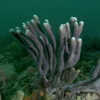General Description
An orange, massive sponge species with irregular form. Size of about 30 cm.
Biology
This species is able to excavate into limestone or calcareous substrates.
Habitat
Reef areas, to depth of 30 m.
Sponge gardens
Reefs
Distribution guide
Port Phillip in Victoria.
Species Group
Depth
Water Column
Max Size
30 cm
Diet
Plankton or particles
Commercial Species
No
Global Dispersal
Recorded in Australia
Species Code
sp. MoV 6712
Identify
Conservation Status
- DSE Advisory List : Not listed
- EPBC Act 1999 : Not listed
- IUCN Red List : Not listed





